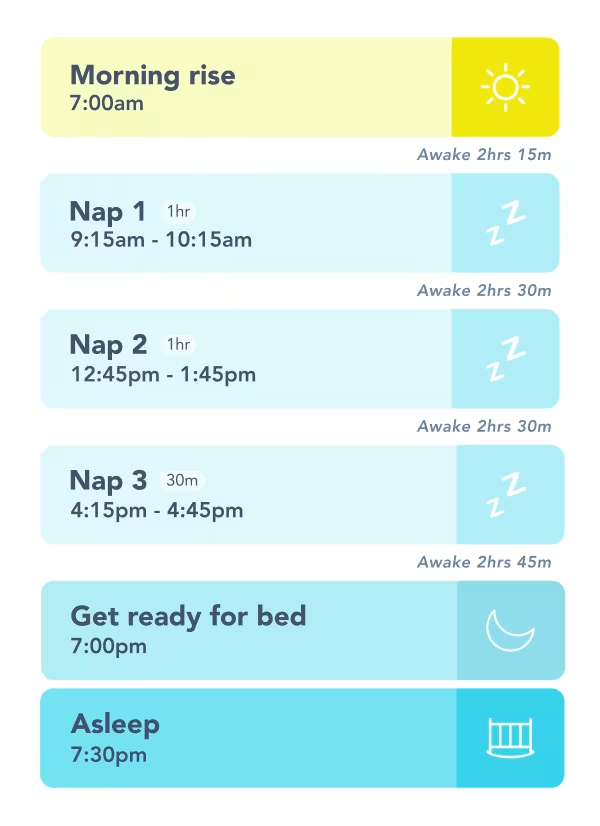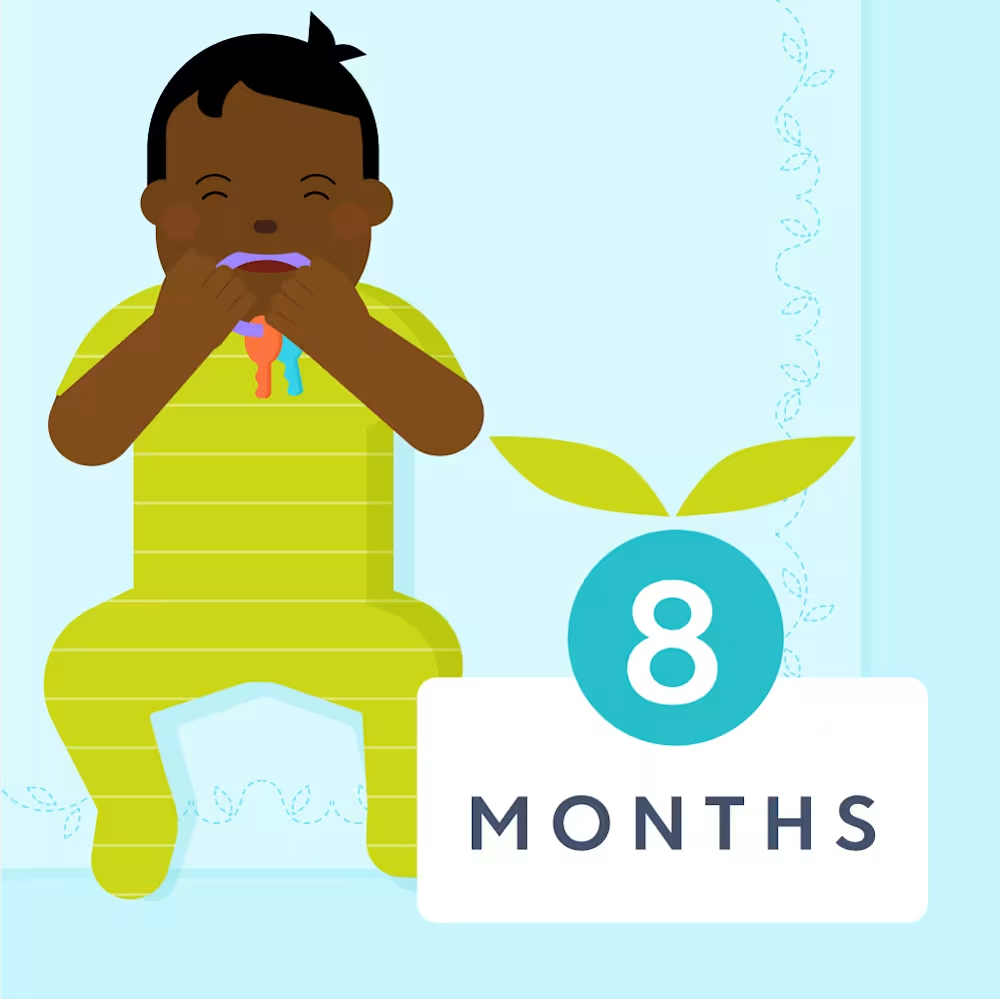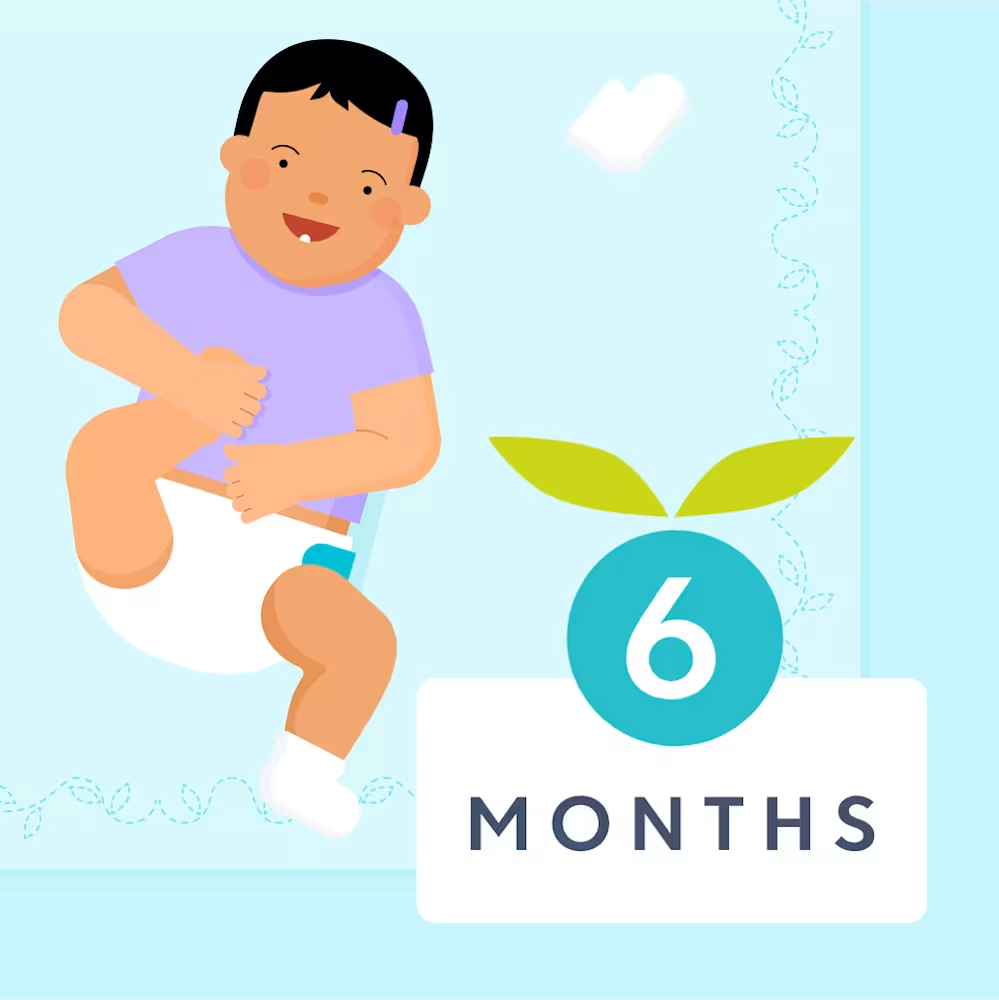7 month old sleep schedule: Bedtime and nap schedule
Updated Dec 10, 2025

At, your baby may be doing many things, including getting ready to shift to 2 naps, although most continue to need 3 naps for another month or so.) In this article we’ll provide you with sample schedules and everything you need to know about your 7 month old’s sleep at this stage of development.
Let's chat about sleep at 7 months
Editor's note
The recommendations listed below represent the average amount of sleep typically needed at this age. However, please note there is a range of normal as some children have lower or higher sleep needs. Your child’s schedule may vary, and that is normal.
Table of Contents
How much should a 7 month old sleep?
Ideally, your 7 month old’s sleep schedule will allow for about 14 hours of total sleep in a 24-hour period, which aligns with the American Academy of Sleep Medicine’s recommendations [] for this age group.
Remember that the amount of sleep babies need can vary, and what is considered normal and healthy has a range. Don't fret about the numbers. The suggested hours are just a rough estimate, and it's equally important to monitor your child's mood and energy levels to ensure they’regetting enough sleep.
We recommend aiming for 11 - 12 hours at night and 2.5 - 3 hours during the day, split over three naps. However, you may find that your baby’s nighttime sleep gets a bit shorter until they completely drop the third nap in the next month or two. This happens when a baby needs more awake time between sleep periods but isn’t quite ready to drop a nap — resulting in a later bedtime and shorter night’s slumber.
Here's a quick overview of what you may expect when it comes to 7 month olds and sleep. Note that these figures are averages and should be used as guidelines.
| Average total sleep | 14 hours |
| Number of naps | 2 - 3 |
| Goal daytime sleep | 2.5 - 3 hours |
| Wake windows | 2.25 - 3.5 hours |
Sample 7 month old sleep schedule

Note: Sleep needs vary by child, and this chart should be viewed as an example only.
Morning rise: 7:00 AM
Wake window before first nap: 2.25 hours
First nap: 9:15 AM - 10:15 AM (1 hour nap)
Wake window before second nap: 2.5 hours
Second nap: 12:45 PM - 1:45 PM (1 hour nap)
Wake window before third nap: 2.5 hours
Third nap: 4:15 PM - 4:45 PM (30 minute nap)
Get ready for bed: 7:00 PM
Wake window before bedtime: 2.5 hours
Asleep: 7:30 PM
Naptime schedule for 7 month old
How long should a 7 month old nap?
A typical nap schedule should allow for 2 - 3 hours of daytime sleep. Expect your baby to take 2 - 3 naps each day. Ideally, the first 2 (or only 2) naps of the day will be at least an hour long. For babies taking 3 naps, the last one is expected to be a shorter power nap of 30 - 45 minutes. Most 7 month old's wake windows are around 2.25 - 3.5 hours so baby is sufficiently tired before sleeping again.
How many naps for a 7 month old?
Most 7 month old babies need a day. However, it’s common to see nap resistance at this age, as babies need longer wake times to build sufficient sleep pressure (this homeostatic sleep pressure [] helps ensure that a baby is tired enough to sleep well).
This often leads to a lot of skipped third naps. As a result, your 7 month old’s nap schedule may not be as predictable as you would like.
Some babies will begin to transition to on the earlier side. We find that babies with strong independent sleeping skills tend to drop naps earlier. If this describes your baby, you’ll want to be on the lookout for signs of the next nap transition, which include a pattern of shorter naps, skipped naps, and/or less than 10 hours of nighttime sleep.
When your baby starts transitioning to a 2-nap schedule, they’ll likely toggle between some 2-nap days and some 3-nap days until they’re ready to drop that third nap fully.
2-nap schedule
| Morning rise | 7:00 AM |
| 1st nap | 9:30 AM - 11:00 AM (1.5 hour nap); 2.5 hours of awake time before 1st nap |
| 2nd nap | 2:15 PM - 3:45 PM (1.5 hour nap); 3.25 hours of awake time before 2nd nap |
| Get ready for sleep | 6:45 PM |
| Asleep | 7:15 PM; 3.5 hours of awake time before bed |
3-nap schedule
| Morning rise | 7:00 AM |
| 1st nap | 9:15 AM - 10:15 AM (1 hour nap); 2.25 hours of awake time before 1st nap |
| 2nd nap | 12:45 PM - 1:45 PM (1 hour nap); 2.5 hours of awake time before 2nd nap |
| 3rd nap | 4:15 PM - 4:45 PM (30 minute nap); 2.5 hours of awake time before 3rd nap |
| Get ready for sleep | 7:00 PM |
| Asleep | 7:30 PM; 2.75 hours of awake time before bed |
Top sleep tips for your 7 month old
Anchor the first nap of the day. Offering the first nap of the day at a set time helps regulate a baby’s circadian rhythm, preventing early wakings from shifting the day earlier. It stabilizes the daily schedule, ensuring balanced wake windows and preventing overtiredness. Over time, this consistency reinforces better sleep habits, making naps, bedtime, and transitions to set schedules smoother.
Create predictable bedtime and nap routines. A consistent sleep routine can help signal that it's time for sleep. In addition to making sure your baby is fed and has a clean diaper, your nighttime routine might include taking a bath, reading a book, or listening to relaxing music. The nap routine is typically a shorter version of your usual bedtime rituals.
Offer 3 naps a few times per week. If your baby has transitioned to 2 naps and you’re suddenly seeing increased night waking (or early morning wakings), overtiredness may be to blame. Offer 3 naps a few times per week to help “reset” their overtiredness and get them back on track.
Teach sleep independence. Babies who are able to fall asleep without external help (such as patting, rocking, or feeding to sleep) can use those same skills to link sleep cycles during the night and after a short nap. In other words, babies who fall asleep on their own are more likely to sleep longer stretches.
Keep the bedroom dark. Your 7 month old is probably very curious about the world, and this can make settling to sleep challenging. A really dark bedroom can mean longer naps and later wakeups, especially when it’s light outside. If the room is too light, they can become distracted by their surroundings and fully awaken, while a dark room encourages them to link sleep cycles and fall back to sleep.
Editor's note
The third nap can be really hard to get at this age, despite a parent’s best efforts. Instead of trying to stretch a tired baby to their regular bedtime, offer an earlier bedtime (but not earlier than 6:00 PM) to help offset their overtiredness when they skip a nap.
Is there a 7 month old sleep regression?
Contrary to common belief, there isn't evidence to suggest that every baby experiences a predefined sleep regression at a specific age.
However, we do notice distinct patterns within particular age ranges that can disrupt sleep for many children. While these are often referred to as "regressions," they are better understood as expected shifts in sleep patterns. We commonly see sleep challenges between 7 - 10 months that are referred to as the "".
Bedtime for 7 month old
Most 7 month olds do best with 11 - 12 hours of sleep at night, so bedtime should be 12 - 13 hours after their wake-up time. That said, if your baby needs longer awake windows on the 3-nap schedule, they may only be able to sleep for 10 - 11 hours at night. In those cases, bedtime will be 13 - 14 after waking for the day.
Keep in mind that your baby’s last nap will affect bedtime too. Since your baby needs at least 2.5 hours of awake time before bed, you’ll want to consider the timing of the last nap when planning bedtime. In some cases, it’s better to offer an earlier bedtime instead of a very late third nap (as that can diminish nighttime sleep).
What time should a 7 month old go to bed?
It’s common for babies to go to bed between 7:00 PM - 8:00 PM. However, the best bedtime for your baby depends on their morning rise time and the time their last nap ended.
Why does my 7 month old keep waking up at night?
If your little one is frequently waking up and calling out for you overnight, they may be , sick, or working on developmental milestones. Another common reason babies call out overnight is because they’re used to receiving help falling asleep at bedtime and want that same assistance in the middle of the night when they wake up.
There’s nothing wrong with helping your baby fall asleep by rocking, patting, or feeding to sleep. However, continuing these sleep associations past the point where it’s developmentally necessary can lead to frequent night wakes and poor sleep for children and parents. If this sounds familiar and you’re looking for more sleep support, consider submitting for a personalized Sleep Plan via .
Can my 7 month old sleep with a pacifier?
At 7 months, it’s safe for your baby to sleep with a pacifier. Doing so may help soothe them during sleep times (and awake times too). On the other hand, at 7 months your baby may become distraught if their pacifier falls out of their mouth while they’re sleeping and cry out for you to replace it. Babies at 8 months may not have the hand-eye coordination to replace their own pacifier yet, but now is a great time to practice helping them hold it and move it slowly to their mouth. Repeating this motion can eventually help them learn to do it themselves!
Note that the AAP does not recommend forcing your baby to take a pacifier or using it to delay (or replace) feedings that are vital for growth and brain development [].
Can I sleep train a 7 month old?
Yes, most babies are developmentally ready for sleep training at . If you’re looking to help your baby learn the skill of falling asleep on their own, there are various to consider. Some techniques are more gradual and take a bit longer to see results and others prioritize speed and results. It’s up to you to decide if sleep training is right for your family!
Can a 7 month old sleep on their stomach or side?
The AAP recommends that 7 month old babies always be placed on their backs in their sleep space []. However, your baby is likely rolling at this age so you can let them sleep on their stomach or side if they move positions while sleeping.
Should I swaddle my 7 month old?
By 7 months, we recommend moving away from swaddling if you haven’t already, especially since most little ones are rolling and practicing independent sleep skills at this age. Beyond safety, we don't recommend swaddling at 7 months because learning to self-soothe and fall asleep independently are key to reducing sleep challenges as babies grow.
What are the developmental milestones for a 7 month old?
, your baby is likely working on things like sitting up (with or without support), rolling, putting things in their mouth, and making adorable noises to express themselves. Here’s a list of other things your baby may trying at this age:
Rolling well both ways
Sitting up (assisted then unassisted)
Move objects from one hand to another
Place items directly in their mouth
Rake objects closer to them
See in full color
Track moving objects well
Babble a chain of sounds
Respond to own name and various noises
Pick up emotions through tone of voice
Express joy or displeasure through sounds
Does a 7 month old need to eat during the night?
Many babies are able to sleep long stretches at and don’t require night feedings. However, some babies sleep better with a night feeding. This often looks like a “dream feed” around your bedtime or a very early morning bottle or nursing session (usually between 3:00 AM and 5:00 AM). If you have specific questions about your little one’s nutritional needs at 7 months, reach out to their pediatrician or lactation consultant for guidance.
Takeaway
Most 7 month old babies will need around 14 hours of total sleep over a 24-hour period: 11 - 12 hours of sleep at night and 2.5 - 3 hours of daytime sleep.
It's common for 7 month olds to continue napping 3 times a day, though some will drop to 2 naps on the earlier side. There might be a transition period where they toggle between some 2-nap days and some 3-nap days until they’re ready to drop that third nap fully.
Most 7 month old's wake windows are around 2.25 - 3.5 hours so baby is sufficiently tired before sleeping again.
If you're curious about what lies ahead in the coming month, glimpse into the future to see what you might experience once your baby is on an . Also take a look at how far your little one has come by checking out a .
7 month old baby sleep FAQ
Share article:
Note: The content on this site is for informational purposes only and should not replace medical advice from your doctor, pediatrician, or medical professional. If you have questions or concerns, you should contact a medical professional.
6 Sources
Table of Contents
Share article:






